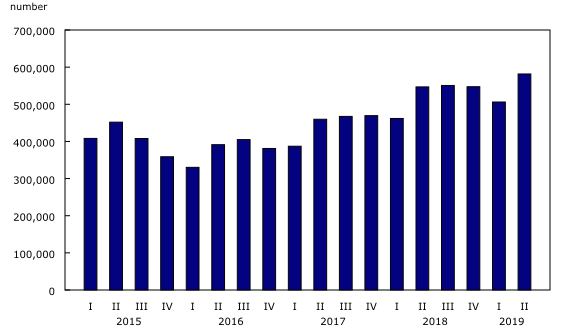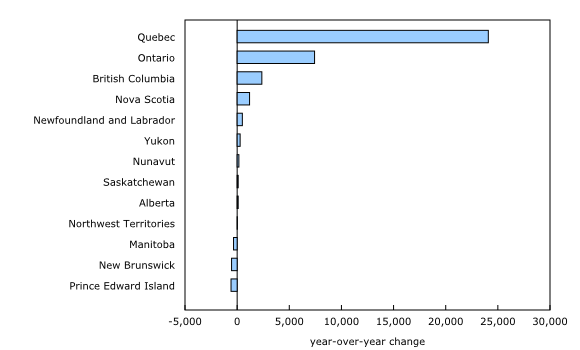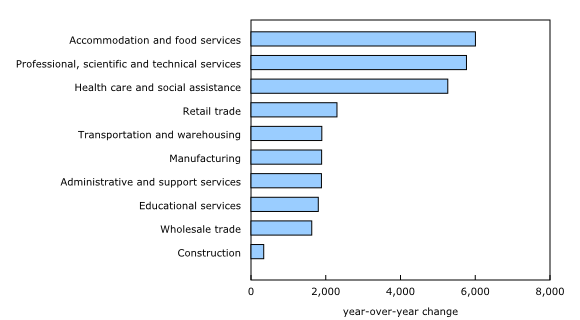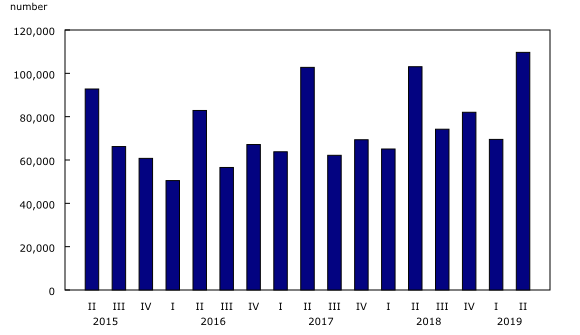Job vacancies, second quarter 2019
Archived Content
Information identified as archived is provided for reference, research or recordkeeping purposes. It is not subject to the Government of Canada Web Standards and has not been altered or updated since it was archived. Please "contact us" to request a format other than those available.
Released: 2019-09-20
Highlights
On a year-over-year basis, both the number of job vacancies and the job vacancy rate increased in the second quarter.
The number of job vacancies was up in four provinces and two territories, with Quebec accounting for nearly 70% of the national increase.
Job vacancies increased in 6 of the 10 largest industrial sectors, led by accommodation and food services; professional, scientific and technical services; and health care and social assistance.
In the second quarter, nearly one in five vacancies was for seasonal positions.
Job vacancies and the job vacancy rate continue to rise
The number of job vacancies in the second quarter was 581,600, up 34,800 (+6.4%) from the second quarter of 2018. This was the 11th successive quarter with year-over-year growth in the number of vacancies. In nearly all of these 11 quarters, year-over-year growth in the number of vacancies outpaced growth in employment as measured by the Survey of Employment, Payrolls, and Hours (SEPH).
As vacancies have grown at a faster pace than employment, the job vacancy rate has also continued to rise. From the second quarter of 2018 to the second quarter of 2019, the job vacancy rate increased by 0.1 percentage points to 3.5%, the highest rate since comparable data became available in 2015.
The job vacancy rate represents the number of job vacancies expressed as a percentage of labour demand, that is, the sum of all occupied and vacant jobs.
In addition to the year-over-year increase, vacancies were also up in the second quarter compared with the first quarter. This may partly reflect seasonal recruitment patterns, as an increase in the number of job vacancies from the first quarter to the second quarter has been observed every year since comparable data became available in 2015.
Job vacancies up in four provinces and two territories
Compared with the second quarter of 2018, the number of job vacancies in the second quarter of 2019 grew in four provinces and two territories: Quebec, Ontario, Nova Scotia, Newfoundland and Labrador, Yukon, and Nunavut. The job vacancy rate also rose in all of these jurisdictions, with the exception of Ontario, where it was unchanged.
At the same time, a decline in both the number of vacancies and the job vacancy rate was recorded in Prince Edward Island. The job vacancy rate also decreased in New Brunswick, while the number of vacancies was little changed. The number of vacancies and the job vacancy rate were both little changed in the remaining provinces and in the Northwest Territories.
In Quebec, the number of job vacancies was up by 24,100 (+20.7%) compared with the second quarter of 2018, accounting for nearly 70% of the national increase. Growth was widespread across sectors and economic regions (ERs). Over the same period, the job vacancy rate in the province increased by 0.6 percentage points to 3.8%, the highest rate since comparable data became available in 2015. From the second quarter of 2018 to the second quarter of 2019, the unemployment rate in Quebec decreased from 5.3% to 4.9%, as recorded by the Labour Force Survey.
In the second quarter, the number of job vacancies in Ontario increased by 7,400 (+3.6%) on a year-over-year basis, led by wholesale trade. The job vacancy rate in the province was unchanged at 3.3%, as payroll employment also grew.
The overall number of vacancies in British Columbia was little changed compared with one year earlier, as increases in health care and social assistance, and professional, scientific, and technical services were offset by declines in retail trade and construction. While the job vacancy rate in British Columbia (4.6%) remained the highest among the provinces, it was little changed from one year earlier, marking the first quarter with no year-over-year increase in the rate since the fourth quarter of 2016.
On a year-over-year basis, the number of vacancies and the job vacancy rate were little changed across the Prairie provinces in the second quarter. Job vacancy rates in Alberta (3.0%), Manitoba (2.6%), and Saskatchewan (2.4%) were among the lowest of all the provinces and territories.
Employers in Prince Edward Island reported 600 (-20.1%) fewer vacancies in the second quarter compared with one year earlier. Over the same period, the job vacancy rate declined by 1.1 percentage points to 3.6%, with decreases in 5 of the 10 largest industrial sectors. While the number of vacancies and the job vacancy rate were down on a year-over-year basis, they were similar to those observed two years earlier in the second quarter of 2017.
Job vacancy rate increases or holds steady in the majority of economic regions
ER data highlight the diversity of regional labour markets across Canada.
In the second quarter of 2019, 23 of the 69 ERs recorded increases in their job vacancy rates compared with one year earlier. Several northern or rural ERs recorded notable rises, including West Coast–Northern Peninsula–Labrador, Newfoundland and Labrador (+1.6 percentage points), Côte-Nord and Nord-du-Québec, Quebec (+1.5 percentage points), North Shore, Nova Scotia (+1.1 percentage points), and Northeast, Ontario (+0.9 percentage points).
Year-over-year decreases in the job vacancy rate were recorded in 11 ERs, with three of the largest occurring in Alberta regions: Camrose–Drumheller (-1.2 percentage points), Red Deer (-1.1 percentage points), and Lethbridge–Medicine Hat (-0.8 percentage points).
The job vacancy rate was little changed compared with the same quarter in the previous year in the remaining 35 ERs.
Job vacancies rise in 6 of the 10 largest industrial sectors
From the second quarter of 2018 to the same quarter in 2019, the number of job vacancies grew in 6 of the 10 largest industrial sectors (in terms of employment). Growth over this period was driven by accommodation and food services; professional, scientific and technical services; and health care and social assistance.
Among the smaller sectors, the number of vacancies increased in agriculture, forestry, fishing, and hunting, reaching the highest level for this sector since comparable data became available in 2015. Vacancies also increased in information and cultural industries, mostly in telecommunications and broadcasting.
The number of job vacancies in accommodation and food services increased by 6,000 (+8.4%) from the second quarter of 2018 to the same quarter of 2019. Quebec and Alberta contributed the most to the rise, while relatively large growth was also observed in Manitoba and Nova Scotia. The job vacancy rate in this sector increased by 0.4 percentage points to 5.6%, and the average offered hourly wage rose by $0.60 (+4.4%) to $14.25. The largest increases in the average offered wage were in British Columbia, Alberta, and Quebec—all provinces where the minimum wage has increased since the second quarter of 2018.
In professional, scientific, and technical services, the number of job vacancies was up by 5,800 (+16.9%) from the second quarter of 2018 to the second quarter of 2019. The increases occurred almost entirely in Quebec, British Columbia, and Alberta. These three provinces account for nearly half of total payroll employment in this sector, according to SEPH. The job vacancy rate in the sector increased by 0.4 percentage points to 4.0%, and the average offered wage was little changed at $29.90 per hour.
Employers in health care and social assistance reported 5,300 (+8.4%) more job vacancies in the second quarter of 2019 compared with one year earlier. This was due almost entirely to increases in Quebec and British Columbia. The job vacancy rate in this sector rose by 0.2 percentage points on a year-over-year basis to 3.3%, the highest since comparable data became available in 2015. The average offered hourly wage was little changed at $23.60.
Compared with one year earlier, the number of job vacancies in the manufacturing sector increased by 1,900 (+3.8%) in the second quarter of 2019, driven by Quebec. At the national level, just over half of the increase within the sector was in the fabricated metal products industry. The average offered hourly wage for vacant positions in this sector rose by $1.10 (+5.3%) to $21.75, while the job vacancy rate was unchanged at 3.1%.
The number of job vacancies in the educational services sector was up by 1,800 (+12.7%) on a year-over-year basis, mostly in Ontario, and the job vacancy rate increased by 0.1 percentage points to 1.1%. The average offered hourly wage decreased by $0.60 (-2.2%) to $26.65. This was the only industrial sector to see a decline in the average offered wage. Changes in the average offered wage can reflect both wage changes and changes in the distribution of vacancies.
Spotlight on seasonal vacancies
In the second quarter of 2019, the number of job vacancies for seasonal positions increased by 6,600 (+6.4%) compared with one year earlier, the same rate of growth observed for total vacancies. Seasonal vacancies accounted for nearly one-fifth of all vacancies (18.9%), little changed from the same quarter in 2018. The number and proportion of seasonal vacancies are typically highest in the second quarter of each year, as employers look to hire workers for the summer season.
Five occupations accounted for about one-quarter (24.6%) of all seasonal vacancies in the second quarter. Three of the five—landscaping and grounds maintenance labourers; program leaders and instructors in recreation, sport, and fitness; and general farm workers—were notable seasonal occupations, with seasonal positions accounting for more than 60% of all vacancies. The remaining two occupations—retail salespersons; and food counter attendants, kitchen helpers, and related support occupations—had the highest number of total vacancies in the quarter, but showed a less pronounced seasonal pattern.
Note to readers
The Job Vacancy and Wage Survey (JVWS) provides comprehensive data on job vacancies and wages by industrial sector and detailed occupations for Canada, the provinces, territories and economic regions. Job vacancy and offered wage data are released quarterly.
Estimates by sector are based on the North American Industry Classification System 2017 Version 3.0. Estimates by geographical area are based on the Standard Geographical Classification 2016. Estimates by occupation reflect the National Occupational Classification (NOC) 2016 Version 1.2. The NOC is a four-tiered hierarchical structure of occupational groups with successive levels of disaggregation. The structure is as follows: 1) 10 broad occupational categories, also referred to as one-digit NOC; 2) 40 major groups, also referred to as two-digit NOC; 3) 140 minor groups, also referred to as three-digit NOC; and 4) 500 unit groups, also referred to as four-digit NOC.
Collection of the wage component was suspended in January 2018. A study is being conducted on how to provide more detailed information by regions and occupations. Collection of wage information will resume on the basis of the study results.
JVWS data are not seasonally adjusted. Therefore, quarter-to-quarter comparisons should be interpreted with caution as they may reflect seasonal movements.
This analysis focuses on differences between estimates that are statistically significant at the 68% confidence level.
Summary statistics related to the job vacancy time series from the Survey of Employment, Payrolls and Hours (SEPH) are available in tables 14-10-0224-01, 14-10-0225-01, 14-10-0226-01 and 14-10-0227-01.
SEPH data used in this Daily are three-month moving averages from May 2019, to better align the data with the reference period of the JVWS.
Labour Force Survey data used in this Daily are three-month moving averages from June 2019.
Data quality of the Job Vacancy and Wage Survey
The target population of the survey includes all business locations in Canada, excluding those involved primarily in religious organizations and private households. Federal, provincial and territorial administrations are also currently excluded from the survey.
Next release
Job vacancy data from the JVWS for the third quarter will be released on December 17.
Products
More information about the concepts and use of data from the Job Vacancy and Wage Survey is available online in the Guide to the Job Vacancy and Wage Survey (75-514-G).
The product "Labour Market Indicators, by province, territory and economic region, unadjusted for seasonality" (71-607-X) is also available. This dynamic web application provides access to Statistics Canada's labour market indicators for Canada, by province, territory and economic region, and allows users to view a snapshot of key labour market indicators, observe geographical rankings for each indicator using an interactive map and table, and easily copy data into other programs.
Contact information
For more information, contact us (toll-free: 1-800-263-1136; 514-283-8300; STATCAN.infostats-infostats.STATCAN@canada.ca).
To enquire about the concepts, methods or data quality of this release, contact Martha Patterson (613-299-3942; martha.patterson@canada.ca), Centre for Labour Market Information.
- Date modified:





